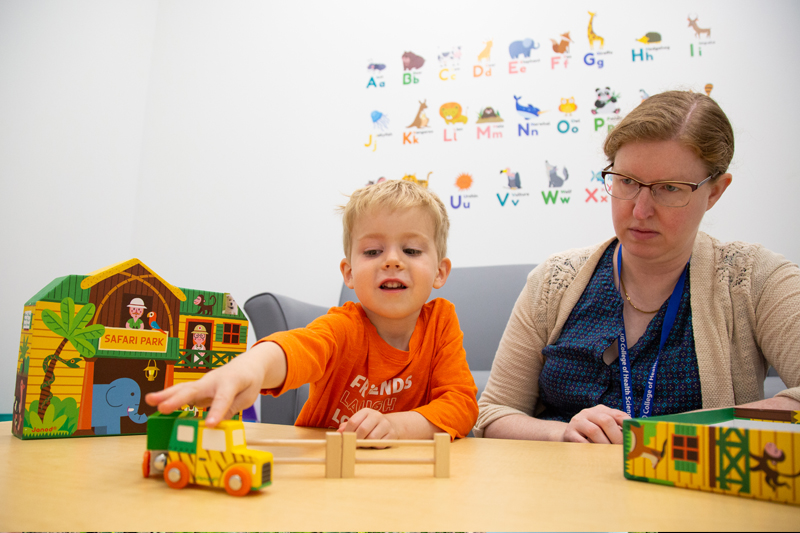


Helping bilingual children
Photo by Ashley Barnas October 19, 2023
UD awarded $3M+ grant to test intervention on bilingual children with developmental language disorder
Amanda Owen Van Horne sits on the floor while a child mixes up cake batter in a play kitchen.
While at play, an intensive language therapy program is also underway for preschool-aged children with developmental language disorder (DLD) at the University of Delaware’s Treatment Efficacy and Learning Language (TELL) Lab. The child says, “Him cooking.” Owen Van Horne repeats back, “He is cooking.”
DLD is a problem with learning and using language not attributed to a hearing impairment or intellectual disability, according to DLD and Me, an organization that aims to raise awareness of DLD on which Owen Van Horne serves on the board. One of the hallmark signs of DLD is an inability to speak in complete grammatical sentences.
“DLD is not just a problem with how you pronounce words; the disorder interferes with understanding and using language,” Owen Van Horne said. “So, we try to reuse what the child already said because it tells us they know the word; they’re interested in the topic, and if we reuse those sentences and turn them into longer, more complex and grammatically correct sentences, the child also has the cognitive resources to realize what I said, and whether I added ‘is’ to form the complete sentence.”
Owen Van Horne, professor of communication sciences and disorders at UD’s College of Health Sciences, and her colleague, Anny Castilla-Earls, professor of communication sciences and disorders at the University of Houston, are testing recast therapy as a language intervention for bilingual children with DLD for the first time. Together, they seek to learn whether the language of instruction impacts syntax learning.
Owen Van Horne and Castilla-Earls have been awarded a five-year $3.27 million grant from the National Institute on Deafness and Other Communication Disorders to further define the relationship between a child’s language proficiency in English or Spanish and the language of instruction to determine whether that impacts learning.
A pilot study launched during the COVID-19 pandemic involving 11 students with DLD from Texas yielded promising results. It was published over the summer in the Journal of Speech, Language, and Hearing Research.
“When we taught in one language, most kids benefitted in the other language,” Owen Van Horne said. “That’s not what we expected to find, and we’re pretty excited to build on that conclusion.”
The findings may shed new light on how language is stored and processed in the brain.
“If I teach you in English, and it benefits you in Spanish, that’s a hint that we have one language store in the brain,” Owen Van Horne explained. “What we don’t know yet is if we teach a child in their weaker language, does it also help them speak in the language they are more proficient in?”
This expanded five-year study involving 140 kids ages 4 to 6 in Texas will seek to answer that crucial question.
“There’s some evidence from adult second language users that they better learn new material in their stronger language, and then it carries over to their less dominant language,” Owen Van Horne said. “We suspect that happens in children, but we need to study it in more children to determine how the language of intervention interacts with language proficiency.”
U.S. Census Bureau data revealed more than 8.5 million children in the U.S. speak Spanish at home.
“We must help kids maintain their home language because that's the language they use to tell stories with their grandma, cook in the kitchen with their mom, or read books in their native language,” Owen Van Horne said. “So, it’s really important that we're not so English-focused that we forget that a child is a whole person. They need to be able to communicate in all their languages.”
The results could also affect staff allocations. Spanish-speaking speech-language pathologists (SLPs) are in high demand in Delaware and nationwide.
“The long-term goal is to provide guidance on how to match SLPs who speak a specific language to children’s needs so schools can provide a better match of personnel to service-delivery needs,” she said.
Early intervention is critical for children with DLD, with Owen Van Horne pointing to past studies on preschool language interventions that show every dollar spent on early intervention saved $8 in special education. The invisible impairment, if untreated, can result in lifelong consequences ranging from academic and employment outcomes to social relationships and mental health.
“It affects everyday functioning from listening in the classroom to a person’s ability to tell their story or follow directions,” Owen Van Horne said. “For example, a teacher might think a child is sloppy or can’t spell because they told them to write in complete sentences, but really, they can’t, or in a conflict with the police, a person with DLD may not be able to tell their side of the story.”
A 2018 study published in the International Journal of Language & Communication Disorders found fewer kids with DLD also graduate from high school. Past research by F. Sayako Earle, associate professor of communication sciences and disorders, and Stephanie Del Tufo, assistant professor in UD’s College of Education and Human Development and the Interdisciplinary Neuroscience Graduate Program, published in the Journal of Learning Disabilities, shows that language and reading impairments affect how college students perform as well.
“DLD has been shown to affect employment outcomes,” Owen Van Horne said. “These individuals are intelligent but struggle with the language piece that wraps into every part of our lives. That’s why it’s so essential that we determine the language of treatment and its impacts on learning bilingual children to better support this underserved population.”
Contact Us
Have a UDaily story idea?
Contact us at ocm@udel.edu
Members of the press
Contact us at 302-831-NEWS or visit the Media Relations website

